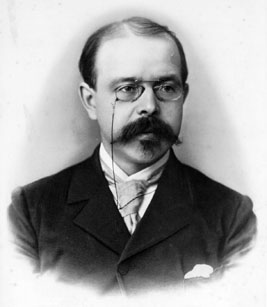| Walther Nernst  AKA Walther Hermann Nernst AKA Walther Hermann Nernst
Born: 25-Jun-1864
Birthplace: Briesen, West Prussia, Germany
Died: 18-Nov-1941
Location of death: Muskau, Germany
Cause of death: Heart Failure
Remains: Cremated, Göttingen City Cemetery, Göttingen, Germany
Gender: Male
Race or Ethnicity: White
Sexual orientation: Straight
Occupation: Chemist Nationality: Germany
Executive summary: Third Law of Thermodynamics German chemist and physicist Walther Nernst studied under Ludwig Boltzmann and Wilhelm Ostwald, won the Nobel Prize for Chemistry in 1920, and is generally credited as a founding father of modern physical chemistry.
In 1888 he first reported the concept of the solubility product (concentrations of different types of ions in a single saturated solution), and devised the Nernst Equation, a mathematical formula used to determine the equilibrium reduction potential of a half-cell in an electrochemical cell. In 1891 he proposed what is now termed the Nernst Distribution Law, which governs the behavior of liquids or solids which are partially incapable of being mixed. In 1893 he introduced a theory to describe the disintegration of ionic compounds into water. He also conducted important research in electro-acoustics and astrophysics, and made a fortune with his 1897 invention of the "Nernst Glower", an electric metallic-filament lamp that produced more efficient and natural light than Thomas Edison's bulbs.
In 1903 he suggested use of buffer solutions (mixtures of weak acids and salts), valuable for resistance to changes in acidity or alkalinity. In 1906 he made his most noted contribution to science, with the first formulation of what is now termed the Third Law of Thermodynamics, which, vastly oversimplified, states that all molecular movement stops at absolute zero (0° Kelvin or -273.15 Celsius). In 1911 he was a key organizer of the Solvay Conference in Brussels, the world's first major conference for physicists. In 1918 he explained the photo-induced chain reaction that causes a mixture of hydrogen and chlorine gases to explode when exposed to light.
His two sons were both killed while fighting for Germany in World War I. He was opposed to the racial policies of his nation's Nazi regime, both on principle and because two of his three daughters had married Jewish men. In 1933, he quit his academic post at the University of Berlin in protest at the Nazification of science, and he died at his home eight years later. Father: Gustav Ernst (judge)
Mother: Ottilie Nerger Nernst
Wife: Emma Lohmeyer (m. 1892, d. 1949, two sons, three daughters)
High School: Graudenz Gymnasium, Grudziadz, Poland (1883)
University: Chemistry, University of Zürich (attended)
University: Chemistry, University of Berlin (attended)
University: Chemistry, University of Graz (attended)
University: PhD Chemistry, University of Würzburg (1887)
Scholar: Chemistry, University of Leipzig (1887-90)
Professor: Chemistry, University of Göttingen (1890-1904)
Professor: Physical Chemistry, University of Berlin (1904-33)
Administrator: Institute for Experimental Physics, University of Berlin (1924-33)
German Academy of Science 1905
Knighthood Order Pour le Mérite:1917
Nobel Prize for Chemistry 1920
Royal Swedish Academy of Sciences 1920
Benjamin Franklin Medal 1928 (by the Franklin Institute)
Royal Society 1932 (Foreign Member)
Lunar Crater Nernst (35.3°N 94.8°W, 116 km. diameter)
German Ancestry
Polish Ancestry
Author of books:
Theoretische Chemie vom Standpunkte der Avogadro'schen Regel und der Thermodynamik (Theoretical Chemistry) (1893, chemistry)
Die theoretischen und experimentellen Grundlagen des neuen Wärmesatzes (The New Heat Theorem) (1918, chemistry)
Requires Flash 7+ and Javascript.
Do you know something we don't?
Submit a correction or make a comment about this profile
Copyright ©2019 Soylent Communications
|